This bibliography gathers publications over many years from a variety of researchers exploring topics of agency, directionality, and function (among others) with a special emphasis on CASP members. It began with work from teams within the initial Agency, Directionality and Function project and continues to be populated with papers and articles from diverse researchers looking to further develop and expand ways of working interdisciplinarily on the complex theme of teleology.
Included in the bibliography are entries for publications and books that many scholars involved in the Agency, Directionality and Function project recommended as foundational texts in their field of study. We welcome suggestions for additions to the bibliography from CASP members.
Transitions in Agency/Individuality
Arora, G., Banerjee, M., Langthasa, J., Bhat, R., & Chatterjee, S. (2023). Targeting metabolic fluxes reverts metastatic transitions in ovarian cancer. IScience, 26(11), 108081.
Black, A.J., Bourrat, P. and Rainey, P.B. (2020). “Ecological scaffolding and the evolution of individuality.” Nature Ecology & Evolution 4:426–436.
Bourrat, P. (2019). “Evolutionary transitions in heritability and individuality.” Theory in Biosciences 138:305–323.
Bourrat, P. (2022). Evolutionary Transitions in Individuality by Endogenization of Scaffolded Properties. The British Journal for the Philosophy of Science, 719118.
Bourrat, P. (2023). A coarse-graining account of individuality: how the emergence of individuals represents a summary of lower-level evolutionary processes. Biology & Philosophy, 38(4), 33.
Bourrat, P. (2023). Multilevel selection 1, multilevel selection 2, and the Price equation: a reappraisal. Synthese, 202(3), 72.
Bourrat, P., Doulcier, G., Rose, C. J., Rainey, P. B., & Hammerschmidt, K. (2022). Tradeoff breaking as a model of evolutionary transitions in individuality and limits of the fitness-decoupling metaphor. ELife, 11, e73715.
Brooks, D. S., DiFrisco, J., & Wimsatt, W. C. (2021). Levels of Organization in the Biological Sciences. MIT Press.
Buss, L. (1987). The Evolution of Individuality. Princeton: Princeton University Press.
Caldwell, J., Knowles, J., Thies, C., Kubacki, F., & Watson, R. (2022). Deep Optimisation: Transitioning the Scale of Evolutionary Search by Inducing and Searching in Deep Representations. SN Computer Science, 3(3), 253.
Caldwell, J., Knowles, J., Thies, C., Kubacki, F., & Watson, R. (2022). Deep Optimisation: Transitioning the Scale of Evolutionary Search by Inducing and Searching in Deep Representations. SN Computer Science, 3(3), 253.
Cornwallis, C. K., Svensson-Coelho, M., Lindh, M., Li, Q., Stábile, F., Hansson, L.-A., & Rengefors, K. (2023). Single-cell adaptations shape evolutionary transitions to multicellularity in green algae. Nature Ecology & Evolution.
Cornwallis, C. K., Van ’T Padje, A., Ellers, J., Klein, M., Jackson, R., Kiers, E. T., West, S. A., & Henry, L. M. (2023). Symbioses shape feeding niches and diversification across insects. Nature Ecology & Evolution.
Doulcier, G., Hammerschmidt, K., & Bourrat, P. (2020). Life history tradeoffs, division of labor and evolutionary transitions in individuality [Preprint]. Evolutionary Biology.
Godfrey-Smith, P. (2009). Darwinian Populations and Natural Selection. Oxford: Oxford University Press.
Godfrey-Smith, P. (2012). “Darwinian individuals.” In From Groups to Individuals: New Perspectives on Biological Associations and Emerging Individuality.” Edited by F. Bouchard and P. Huneman. Cambridge (MA): The MIT Press.
Kalambokidis, M., & Travisano, M. (2023). Multispecies interactions shape the transition to multicellularity. Proceedings of the Royal Society B: Biological Sciences, 290(2007), 20231055.
Lauber, N., Tichacek, O., Narayanankutty, K., De Martino, D., & Ruiz-Mirazo, K. (2023). Modelling spatial constraints and scaling effects of catalyst phase separation on linear pathway kinetics (arXiv:2302.05315). arXiv.
Maynard Smith. J. and Szathmary, E. (1995). The Major Transitions in Evolution. Oxford: Oxford University Press.
Michod, R.E. (2007). “Evolution of individuality during the transition from unicellular to multicellular life.” Proceedings of the National Academy of Sciences, United States of America 104(suppl 1):8613–8618.
Michod, R.E. and Roze, D. (2001). “Cooperation and conflict in the evolution of multicellularity.” Heredity 86:1–7.
Moreno, A. (2007). “A systemic approach to the origin of biological organization.” In Systems Biology: Philosophical Foundations. Edited by F.C. Boogerd, F.J. Bruggeman, J.S. Hofmeyr and H.V. Westerhoff. Amsterdam: Elsevier.
Newman, S.A. (2016). "’Biogeneric’ developmental processes: drivers of major transitions in animal evolution." Philosophical Transactions of the Royal Society B: Biological Sciences 371(1701). https://doi.org/10.1098/rstb.2015.0443.>
Nitschke, M. C., Black, A. J., Bourrat, P., & Rainey, P. B. (2023). The effect of bottleneck size on evolution in nested Darwinian populations. Journal of Theoretical Biology, 561, 111414.
O’Malley, M.A. and Powell, R. (2016). “Major problems in evolutionary transitions: how a metabolic perspective can enrich our understanding of macroevolution.” Biology & Philosophy 31:159–189.

